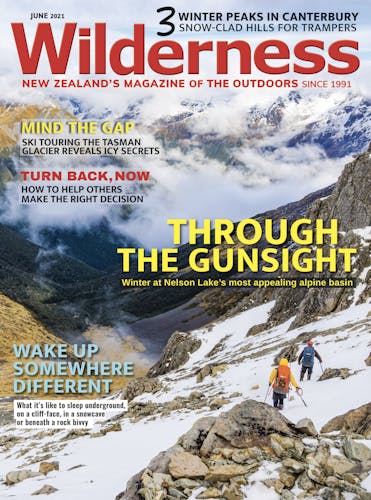When a baby comes along, tramping life can be curtailed. Fortunately, the extensive hut network in this country makes it possible for even the youngest children to go on an overnight hike. By Sue Cardwell
As we waded back and forth across the gently meandering Orongorongo River one January afternoon in Sophie’s seventh month of life, I reflected on the journey that had brought us here.
Not the two hours of beech forest that had led us from car park to river, but the journey from a conversation which happened while hiking almost four years ago (and had been repeated many times since) to today: the moment when we took that dream and tested it in reality.
The crucial question: could this wonderful life of ours, spending our holidays hiking New Zealand’s backcountry, one day be shared with our child?
My partner Julia and I had naively imagined we’d be hiking with Sophie from the early weeks. We’d read all we could about hiking with a baby (not much) and talked to families we met in huts.
It sounded daunting. How exactly did one share a sleeping bag with a tiny, fragile infant? But the mothers (always mothers) sharing their experiences pointed out there’s no better time than when baby feeds on breast milk and is light enough to carry comfortably.
Then, there was lockdown. We focused on just parenting our lively baby and I let go of my dreams of being in the hills in the early days of Sophie’s life.
In the meantime, we trained on short local walks, tried on baby carrier backpacks and I looked for overnight tramping options. Not an easy task.
I considered ‘family-friendly’ excursions but was concerned about the impact on other sleeping trampers of Sophie’s many night wakings.
There were private tracks with sole use huts. Expensive, but guaranteed at least.
I even looked at using DOC’s booking system to pay for an entire hut and then asking friends if they felt like using the spare bunks, with no guarantee of getting any sleep.
Julia, ever practical, added criteria: close to an airport/hospital and not involving any dangerous climbing or river crossings.
The list of options was depressingly short.
We finally felt ready to give it a try when Sophie was seven months old.
The evocatively named Boar Inn is one of a group of sole occupancy DOC huts on the Orongorongo River in the Remutaka Range. Perfect for our needs; we could reach it in less than three hours of gentle tramping and have the place to ourselves.
If the tramp from the trailhead to the hut sounded easy, getting to the track was anything but. The logistics were a pain: finding a motel with a port-a-cot, taking Sophie’s first flight, working out how to get from the airport to our accommodation without our car seat.
After these trials, we were ready for some calming wilderness.

Boar Inn is one of several sole-occupancy huts in Remutaka Forest Park – perfect for the youngest of children
We had splashed out on a beautiful new child carrier. Sophie was just big enough. We couldn’t wait to take her hiking in it.
The excitement was short-lived. It was so much less comfortable than any backpack I’d worn in the past 20 years. I joked that I was Sophie’s palanquin, and took joy in her delight at the forest we travelled through. When we got closer to nap time, she slumped uncomfortably against the straps and began to grizzle. Over she went to the soft front pack where she is used to sleeping. Now Julia was strapped front and back with baby and backpack while I enjoyed the relief of a now-empty child carrier.
Fortunately, we were close to our destination. After 20 minutes of following the river, in and out of its silvery braids, we reached Boar Inn. It was cosy and quaint and cheered us that we had made the right choice in coming here.
The plan was for Sophie to sleep in her sleep sack on a bunk between the wall and me. She would breastfeed as needed when she woke during the night. We fenced her in with spare mattresses and backpacks to avoid any unexpected encounters with the concrete floor.
With Sophie sleeping, we settled in around the table where we could finally say, in whispers by candlelight, ‘we’re doing it, we’re sleeping in a hut with our baby!’
With sore shoulders and happy hearts, that moment felt perfect.
The trip home was marked by our extreme tiredness. Sophie had slept fairly well while Julia and I, conscious of our duty to keep her safe, slept little.
Back home, we put Sophie to bed in her cot and asked each other whether we would do it again?
“Not soon,” said Julia. “Travelling with a baby is hard.”
“But it worked,” I countered. “We can take our baby on overnight trips.”
It was a dream come true and a reality check all in one.







